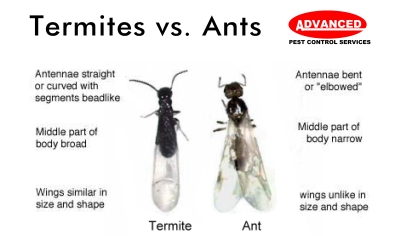Ants Versus
Termites
One of the most common questions we
hear at Advanced Pest Control is how to determine the difference
between an ant infestation and an active termite colony attacking
your home. For New Hampshire residents in the northern part of
our state, there is no worry about termites. From central New
Hampshire through the southern part of the state, termites can be
found in abundance.
As a simple rule of thumb, if the
body of the insect looks just like an ant with wings, it's a flying
ant, not a termite. Here is a comparison:
-
Ant reproductives are defined by
having three distinct body segments (head, thorax, abdomen),
elbowed antennae and clear, pointed wings that are only slightly
longer than the insect's body.
-
Termite reproductives have two
distinct body segments (head & thorax), straight antennae
and translucent, paddle shaped wings that are twice as
long as the body of the insect.

Termites
live in underground colonies and feed on wood products. You may
never see them, even if they're feeding on the lumber that's holding
your house together. Fortunately they work slowly, giving you
several years to discover their presence before they cause
substantial structural damage to your house. You might see a swarm
of termites during the spring due to temperatures and moisture
conditions. A telltale sign is discarded wings on the floor or
windowsills after a warm rain in early spring. But, termites can be
active at other times during the year, such as during the winter in
heated basements.
One way to detect their presence is
by the characteristic pattern of destruction: they eat the soft part
of the wood and leave the annual rings intact. Another sign of their
presence is mud tubes constructed along obstructions they cannot
chew through. However, such signs are not often readily visible.
It is virtually impossible for you to
get rid of termites yourself. Call us if you suspect termites are at
work in or near your house.
Termite
Treatments
Barrier
Treatments- When subterranean termites are found, we can inject
a termite treatment into the soil surrounding your house to create a
continuous barrier that termites won’t cross.
Bait Options- At
Advanced Pest Control, we offer an alternative to traditional
barriers with termite baiting. As every home is different, we will
take the time to assess your specific infestation and recommend the
most effective treatment options. Baits, though effective in some
infestations, are not best in all cases. If a bait solution looks
best for you, we will install bait stations that contain untreated
wood around an infested home. If you have a crawlspace, we may
install one or two stations in this area as well. The bait stations
are positioned at fixed intervals. Termites find the stations during
foraging. Bait stations are inspected periodically to see if
termites are feeding on the untreated wood bait. Once the termites
find the wood bait, poison bait is added to the stations. All
members in the colony exchange the poison until the queen gets her
share of the poison and the colony dies.
Carpenter Ants
are frequently confused with termites because they, too, destroy
wood. Unlike termites, however, they do not eat the wood, preferring
instead to tunnel channels through it in order to enlarge their
living space. Although a carpenter ant has wings, its front pair is
much longer than the back pair; its termite cousin has two pairs of
equal length. Another distinguishing feature of the carpenter ant's
body is a pinched-in waist like that of a wasp.
If you find little piles of sawdust
near the baseboards of your house, suspect that carpenter ants are
at work. Since their nests are extremely difficult to find, we can
help to determine the extent of damage and eliminate the colonies.
Carpenter ants like damp locations:
underground, in dead stumps, and in firewood. They can be found
inside wood structures where there are water leaks: around windows,
chimneys, bathtubs, sinks, and drains. Unlike termites, carpenter
ants do not eat and digest wood. Ants tunnel through and live in
wood. While pressure treated wood can kill termites, it will
not kill ants
Treatment for carpenter ants involves
the application of materials into areas conducive to their activity
and into known nests.
